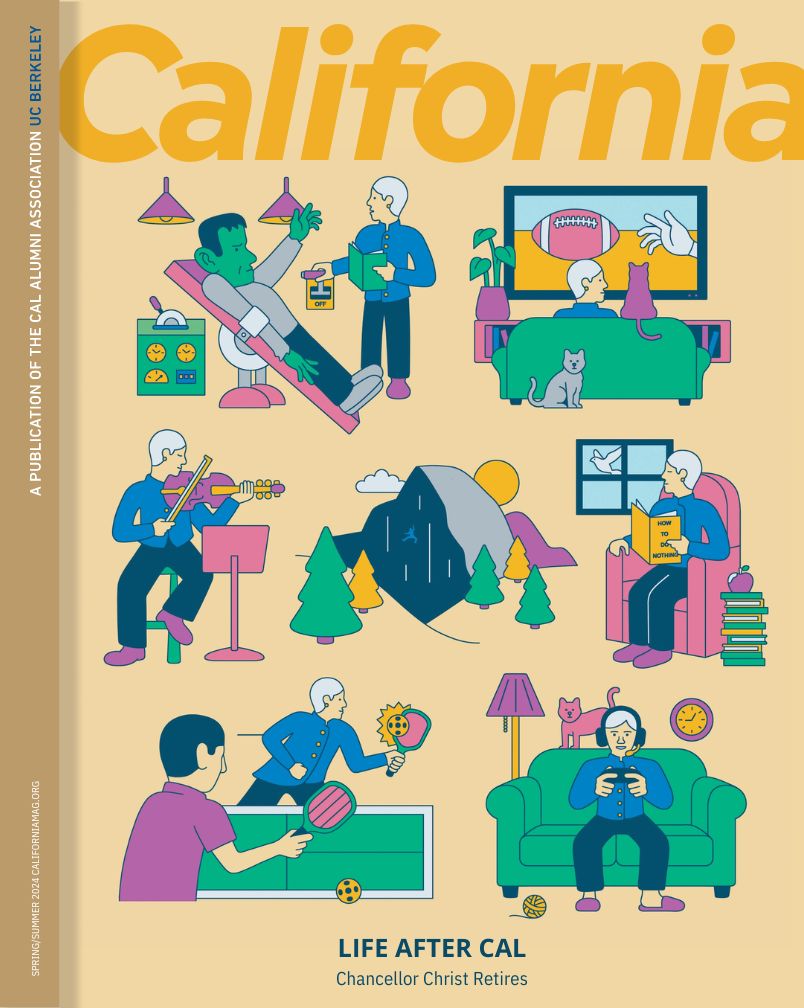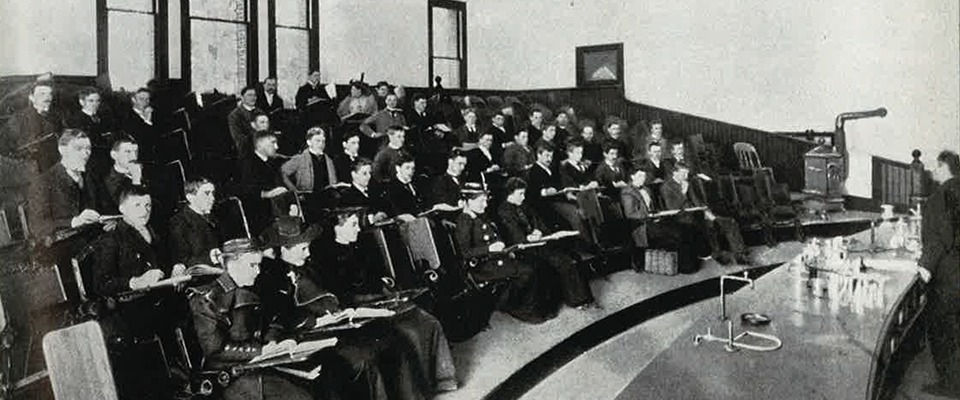Heather R. Johnson
As you swim laps in one of the campus pools or get checked out at the Tang Center, thank Cal’s first female graduates.
The women graduates from Cal’s first 30 years defied assumptions of inferiority and fragility. They earned Ph.D.s and professorships in science, math and economics. They also fought for and raised funds for services vital to campus life, including the first infirmary, women’s gymnasium, women’s housing and student loans.
“They went against the grain of common thought that it would be wasteful for women to go to school,” says Maria Protti ’79, longtime board member and former programs, events and prizes chair for the Prytanean Women’s Honor Society.
 Photography: The Golden Book of California.” />
Photography: The Golden Book of California.” />
“The average freshman, walking to campus for the first time, may not know that most things that surround them were thought of, and influenced, by women. The university is like a living organism, and through the years, women have tinkered with it to make it better.”
Despite societal belief that education would interfere with women’s roles as wives and mothers, UC Berkeley began admitting women in 1870, only two years after it opened. The university also allowed women to take any class they chose; which, at the time, included agricultural, mining and mechanical arts programs. The Register of the University of 1870 said, under its terms of admission, “Young ladies are admitted into the University on equal terms, in all respects with young men.”1
During that first year, 17 women enrolled—five more than the entire 1873 charter class. Four years later, president Daniel Coit Gilman remarked the university had more women who ranked high in scholarship than men.2 By 1900, women comprised 60 percent of the student body—at a time when most U.S. colleges and universities either excluded women or enforced quotas to keep the numbers low.3
Cal’s first women graduates paved the way for female scholars, professionals and leaders to come. Here, we take a look at a few of UC Berkeley’s inaugural women graduates.
 Photography: University of California Catalogue of Graduates.”/>Rosa L. Scrivner
Photography: University of California Catalogue of Graduates.”/>Rosa L. Scrivner
Rosa Scrivner earns recognition as the first woman to receive a degree from UC Berkeley, earning a Ph.B. in agriculture in 1874. Not much is known about Ms. Scrivner (later Mrs. Robinson)’s post-graduate career. According to the Sacramento Daily Union, December 1886, Scrivner received a Life Diploma that year, which is a permanent form of teacher certification.
 Photography: Online Archive of California.”/>Milicent Washburn Shinn (1858–1940)
Photography: Online Archive of California.”/>Milicent Washburn Shinn (1858–1940)
Milicent Washburn Shinn earned a Ph.D.—the first woman at Cal to do so—in education in 1898. Shinn earned her undergraduate degree in 1880, also from Cal.
Shinn, a native of what’s now known as Niles, California, made a mark in two divergent fields: publishing and early childhood development. Two years after earning her undergrad degree, Shinn took a job as editor of Overland Monthly, a literary magazine founded in 1868 by Bavarian bookseller Anton Roman.
By the time Shinn came on board, in 1882, the publication was close to folding. Shinn worked for free because she felt California needed a literary magazine. The magazine stayed in publication until 1935.4, 5
Although Shinn showed promise as an editor, a personal project brought her the most notoriety. While living on the family farm, Shinn started keeping detailed records of her infant niece, Ruth. Possibly to keep her writing and reporting skills sharp, Shinn wrote in detail about Ruth’s development: her growth, reflexes and language.
Shinn compiled more than three years of data on Ruth. Although she did so with no professional intention, child psychologists considered her work groundbreaking. Shinn received an invitation to speak at the World’s Columbian Exposition (a world’s fair) in Chicago in 1893. The presentation led to multiple invitations for graduate study. She chose to stay close to home, pursuing her Ph.D. at Cal.
Shinn published her dissertation, Notes on the Development of a Child, in three installments between 1893 and 1899. The publication became foundational text for developmental psychology classes across the United States.
 Photography: The Bancroft Library.” />Jessica Blanche Piexotto (1864–1941)
Photography: The Bancroft Library.” />Jessica Blanche Piexotto (1864–1941)
Piexotto followed closely behind Shinn as the second woman to earn a Ph.D. from Cal, in political science. She also became the university’s first female professor.
A native New Yorker, Piexotto moved with her parents and three younger brothers to San Francisco in 1870. Piexotto graduated from Girls’ High School in 1880, but studied at home for ten years before entering college6.
With her parents’ disapproval, the young Piexotto enrolled in Cal in 1891. Academic life presumably suited her, as she continued at Cal to pursue graduate degrees in economics and political science. She lived at Cloyne Court.
Piexotto received her Ph.D. in 1900. Thomas Y. Crowell & Company published her thesis, French Revolution and Modern French Socialism, in 1901.
In 1904, Piexotto joined the UC Berkeley faculty as a sociology lecturer. Four years later, she moved to the economics department, where she taught until her retirement in 1935.
In 1918, Cal appointed Piexotto full professor of social economics, making her both the first woman professor and first department head. During this time, she served as vice president of the American Economic Association and on the California State Board of Charities and Correction. She also established the curriculum later used in the School of Social Welfare7.
Prior to her professorship, During World War I, Piexotto served as executive chairperson of the child welfare department of the Women’s Committee of the Council of National Defense. President Woodrow Wilson established the organization to coordinate the domestic war effort. It was the first governmental organization composed of, and focused on, women8.
Piexotto published several books, essays and articles during her UC Berkeley tenure. Both Mills College and Berkeley presented Piexotto with honorary law doctorates in recognition of her professional achievements.
 Photography: Blue and Gold Yearbook 1901 and 1902.” />
Photography: Blue and Gold Yearbook 1901 and 1902.” /> Photography: Blue and Gold Yearbook 1901 and 1902.” />
Photography: Blue and Gold Yearbook 1901 and 1902.” /> Photography: Blue and Gold Yearbook 1901 and 1902.” />Agnes Frisius and Adele Lewis
Photography: Blue and Gold Yearbook 1901 and 1902.” />Agnes Frisius and Adele Lewis
Many of the services and facilities available at Cal today evolved from the hard work of Agnes Frisius (1901) and Adele Gerard Lewis (1902).
The dynamic duo successfully fought for the first women’s gymnasium, a university infirmary (which later became Cowell Memorial Hospital and evolved into the Tang Center), women’s housing and student loans. They achieved most of this work under the Prytanean Society, the oldest collegiate women’s honorary society in the US, which they founded in 1901.
Derived from the Greek word Prytanes, which means, generally, a representative, the Prytanean Society brought together leaders from all disciplines. Frisius and Lewis wanted to establish a respected women’s organization that worked for the greater good of the university.
In its first year, the Prytanean Society raised $5,000—the equivalent of about $138,000 today—to establish a student infirmary. And they did it without the help of banks or investors.
“They sold sandwiches on campus to fund the infirmary,” says Protti. “They also held annual Greek pageants, which brought in about $1,500 a year. They funded a lot of services with the money they raised.”
During Frisius and Lewis’s college years, and prior, women lived cramped in small attics and basements near campus. Only men had dormitories. The Prytaneans pushed for housing, but instead of dorms, they worked to convert nearby houses into university-supported co-ops.
Influenced by Frisius and Lewis’s early work, in 1937 Prytanean Society established Ritter Hall, a women’s co-operative dorm named in honor of pioneering physician Mary Ritter. Frisius and Lewis also played instrumental roles in establishing women’s physical education programs, sports teams and a dedicated gym, which later evolved into Hearst Gymnasium.
 Photography: Internet Archive.” />Annie Dale Biddle Andrews (1885–1940)
Photography: Internet Archive.” />Annie Dale Biddle Andrews (1885–1940)
Annie Dale Biddle showed by example women could excel in math. As the first woman to receive a Ph.D. in mathematics at Cal, in 1911, Biddle wrote her dissertation on “Constructive theory of the unicursal plane quartic by synthetic methods” under the joint supervision of Derrick Lehmer and Mellen Haskell. University of California Press published the work in 1912.
After a short stint teaching mathematics at University of Washington, the newly married Biddle Andrews returned to Cal to teach between 1915 and 1932. In 1933 she presented her research, “the space quartic of the second kind by synthetic,” at an American Mathematical Society meeting in Palo Alto, California. The organization later published her work in its journal.
Cal’s first women graduates showed women across the west that they too had the intellect and ability to pursue college and a career. With none of today’s advantages, they achieved the highest levels of learning. They pursued advanced degrees not only for knowledge’s sake, but to educate future generations.
“If more students knew what these women went through, in addition to just plain learning, they would not be deterred from accomplishing their goals,” says Protti. “They looked for opportunities and created their own.”


















